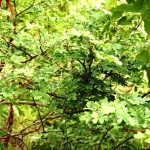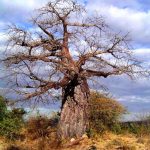TREE LIFE
April 2007
MASHONALAND CALENDAR
Tuesday 3rd April 2007: Botanic Garden Walk. In March we welcomed Tom back and had a very successful walk in the Botanic Gardens. This month we will continue with the Sapindaceae.
Meet in the Botanic Garden car park (mention the Tree Society at the gate and you won’t have to pay) at 4.45 for 5 p.m.
Sunday 15th April 2007: Haka Game Park. A new venue for us. Don’t forget there will be an entry fee per person ($10 000) and a charge for the car ($5 000). Note, however, that these were the prices in early March and obviously they may have increased by the time of our outing.
We will meet at 9.30 a.m.
Saturday 28th April 2007: Ruwa Scout Park. By kind permission of the Scouts. This is a pleasant venue we have visited many times before. There is no entrance fee but a donation would be appreciated, so please bring something with you.
Meeting time: 2.30 p.m.
TREE LIFE – BOUNCING EMAILS
This is a note for those who receive Tree Life by email. Each month emails go out in batches. Sometimes, these emails bounce for one reason or another – fortunately not very many.
In the past I have generally retained that member’s email address on the system and tried again next month.
However, my experience is that they usually bounce again.
From now on, I will remove any email addresses that bounce. If, therefore, you don’t receive your Tree Life by email, please get in touch with me.
SUBSCRIPTION REMINDER FOR 2007/8
Subscriptions are due on 1 August 2007. Although we give in the table below the rates for preparing and sending printed copies we would rather send out Tree Life by email because it is easier and cheaper and there is far less of a risk of cost overruns.
Email Z$ 5,000
Printed copy: collected Z$ 15,000
Printed copy: posted Z$ 25,000
Once again, I must emphasize strongly that we do not want to lose members as a result of these increases. Each year a number of members pay more than the norm so that the excess goes anonymously to support members who may be having financial difficulties. So, please do not be proud; talk to Terry or me.
We would also very much prefer to receive the subscriptions in cash.
However, if paying by cheque, please make it out to CABS and on the reverse ‘Pay to the account of the Tree Society’
-Mark Hyde
MATABELELAND CALENDAR
Please contact Jean Wiley or Gill Short for details of the next Matabeleland function.
RUZAWI: 18TH FEBRUARY 2007
Ruzawi school, where the outing was held, and our generous hosts, the Williams family live, lies on the main watershed at an altitude of 1640 meters. Small, rocky, granite kopjes and gently rolling slopes are the main features of the area. The granitic soils are typical light-grey, coarse, poor and sandy. The area has a relatively high rainfall, witnessed by the extensive lichens, and tree and rock epiphytic orchids.
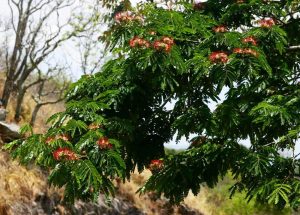
Albizia gummifera. Photo: Bart Wursten. Source: Flora of Zimbabwe
We were welcomed with tea under a magnificent planted specimen of Albizia gummifera. A lively discussion centered on why new msasa leaves are red. This red colour is caused by a group of chemicals called anthocyanins. These chemicals not only make the reds, purples and browns in new leaves, but also act as sunscreens, protecting the new leaves while they are developing their chlorophyll-making cells.
26 people attended, and our group split into two, one group led by Mark Hyde, the other by Meg Coates-Palgrave.
Miombo Woodlands
We drove to the area of our main morning outing, an area of probably secondary growth Miombo, where the maximum trunk size was about 40 cm. No large Msasa trees were seen, and the trees had a stunted look. The dominant tree was Julbernardia globiflora, with lesser numbers of Brachystegia spiciformis. On the ridges could be seen the distinctive shapes of the mountain acacia, no longer called Brachystegia glaucescens, now renamed, Brachystegia tamarindoides.
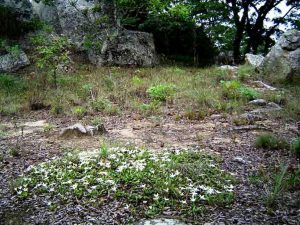
Leptactina benguelensis. Photo: Bart Wursten. Source: Flora of Zimbabwe
The first plant we encountered was the touch-sensitive Biophytum petersianum, a ground hugging herb. On touching the leaves the rhachis folded up, and the compound leaflets folded down under the rhachis. Other small plants of interest were the suffrutex Leptactina benguelensis with its edible yellow gardenia-like fruit and a Disperis anthoceros, an orchid.
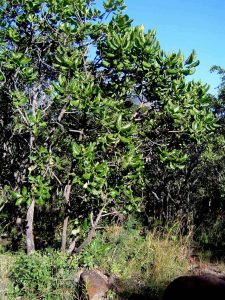
Uapaca kirkiana. Photo: Bart Wursten. Source: Flora of Zimbabwe
Trees of interest were Pittosporum viridiflorum with its breathing lenticels on branches and trunk. The mahobohobo, Uapaca kirkiana, was in flower, both the separate male and female trees. Ekebergia benguelensis, and the firebush Hymenodictyon floribundum, are trees thatcolour the bush with their autumnal splash of red. Two Ochna were seen, the more common Ochna schweinfurthiana, and the near endemic Ochna puberula, which favours granite kopjies. Three Cussonia were present, Cussonia arborea, Cussonia natalensis and Cussonia spicata. I do not recall seeing any Acacia species.
Gum trees and Lilies
An unusual feature of the Marondera area is the association of gum tree plantations and St Joseph lilies (Lilium formosanum). Wherever these gum tree, and to a lesser extent, pine tree, plantations exist, the St Joseph lilies occur. Only in the plantations, not in the surrounding Miombo areas.
Quite extensive areas of Miombo woodland have been cut and replanted with eucalypts. From a conservation viewpoint, at first glance this seems odd, and yet it does make sense. Eucalypts grow at about three times the rate of Msasas. Every gum tree planted means two msasas do not get cut down for firewood! Eucalypts are often maligned, yet they serve a useful purpose. The well named and tall, about 50 meter, Eucalyptus grandis growing around the dam area in the school ground looked particularly splendid, and reminded me of the stands of Eucalyptus regnans that can grow to 80 to 85 meters, in their native Tasmania.
-Bernard Beekes
WELL, WHAT COLOUR IS THE JACARANDA?
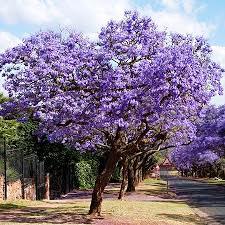
Jacaranda. Source: Wikipedia
Those purple colonnades …. but are they? What hue or tint is the jacaranda? Purple can be the colour of Burgundy or the shade of lavender blue.
It is an extremely delicate shade, which painters find foxy and photographers find baffling.
But these strange South American plants from the Bignoniaceae family have also been called mauve.
There is a jacaranda native to Zimbabwe that is pink.
It is strange that the jacaranda blooms that make Harare and Pretoria such beautiful cities should also make so many suffer. Noses stream, eyes water and the system over-produces histamines with the unfortunate and unpleasant effects.
Yet the jacaranda has a place in herbal medicine and was used in Brazil and other parts of South America as an anti-syphilitic.
The first comprehensive encyclopaedia of herbs, A Modern Herbal, says the jacaranda has been used by aborigines of Brazil for syphilis and other venereal diseases and has been tried in cases of epilepsy.
The species Jacaranda procera has been investigated and is found to contain certain substances and alkaloids. These are caroba balsam, caroborelinic acid, carobic acid, carobon, and the crystalline substance carobin. The native name for the tree in Brazil is caroba.
Despite these substances, the tree is not all that hardy and is prone to attack by termites.
The South American tree Jacaranda acutifolia has the clusters of mauve flowers and the delicate pinnate leaves. It is also known as rosewood, although it is not the true rosewood of commerce. There are several trees of the genus Jacaranda.
The former town engineer of Pretoria, J. J. Jameson, planted the trees there on a grand scale about 1910 and was known as Jacaranda Jim.
The first jacarandas in this country (according to Encyclopaedia Rhodesia) were introduced by A. H. Holland, secretary to Sir William Milton, the Administrator. Mr Holland came to Zimbabwe in January 1897 and left in 1916. He is said to have planted the first jacaranda in front of his house in Cape Avenue, which became Montague Avenue and is now Josiha Chinamano Avenue
Other trees were later ordered for Government House. Mr Holland also imported flamboyant and frangipani trees and planted them in Harare.
The Encyclopaedia also mentions an indigenous jacaranda (Stereospermum kunthianum) also a member of the Bignoniaceae. The Shona name is mukuku.
This pink-flowered tree grows to a height of 12 m. The seeds grow in long pods (up to 45 cm) and blow on paper wings. It grows mainly in the Mutoko, Lomagundi, Shamva and Hwange districts among granite out crops.
Source: anonymous, undated newspaper cutting, kindly supplied by Mrs. Meg Wells.
BOTANIC GARDEN WALK: 6 MARCH 2007
It was a great pleasure to welcome back, after a long break caused by absence and illness, a longstanding friend and supporter of the Tree Society, Dr Tom Muller and to restart the monthly botanic garden walks.
We were just into double figures of members attending (I think we had to count Tom himself to get there) and these included a number of new members. An innovation suggested by Richard Oulton was tried out for the first time at this meeting and consisted of sticking a handwritten label on each person so that we all know who we are. It seemed to work well.
A new member had brought a specimen of a cultivated tree. This had yellow flowers and odd-looking inflated calyces. This turned out to be Koelreuteria paniculata, the Golden-rain tree. By a strange coincidence it also belongs to the family Sapindaceae.
And that was our subject for day, namely the tropical family, the Sapindaceae.
What are the features of this family?
• mainly woody (usually trees and shrubs)
• but two climbing genera (Cardiospermum and Paullinia)
• stipules generally absent
• milky latex generally absent (but present in Paullinia)
• leaves alternate
• leaves mainly compound (but Pappea and Dodonaea have simple leaves)
• leaf rhachis sometimes winged
• inflorescence usually a thyrse (a compound inflorescence)
• flowering parts mostly in 4s and 5s (but petals sometimes absent – e.g. in Zanha)
• ovary superior
• fruit variable (berry, capsule, drupe, samara or schizocarp).
Our first tree was the striking Fern-leaf, Filicium decipiens. This has 1-pinnate leaves that are paripinnate – that is they lack the terminal leaflet. The most striking feature is that both petiole and rhachis is strongly and strikingly winged. The appearance is fern-like, which is the origin of the generic name, while the specific name means ‘deceiving’.
Tom mentioned that this is a true rain forest species, and occurs in the E districts at lower altitudes (up to about 1000 m). For example it occurs in forest patches in the Vumba above the Burma Valley. It also makes a good garden subject.
Regarding forest tree growth in general, Tom remarked that forest trees produce trunks because of the need to reach the light. If a forest tree is planted in the open, it doesn’t bother to produce a trunk but will make a crown on the ground, thereby branching from near the base.
At this point we tried to get into ‘the jungle’ and in the process encountered Costus afer. This is a member of the Ginger family, Zingiberaceae, with white flowers with pink veins clustered in a tight head. It is commonly grown in gardens.
Also present was the climbing species, Paullinia pinnata. Oddly, it is the only one of our species of Sapindaceae (as far as I am aware) that has milky latex. It also has leaves with winged rhachides and it produces tendrils to assist in climbing. It is a species of rain forest in the E Highlands – and also occurs in riverine forest – for example by the Zambezi above the Falls.
Aporrhiza nitida is an understorey tree of forests, occurring in small forests and at grave sites in the Eastern districts. The leaves are paripinnate and glossy.
A very rare tree indeed is Glenniea africana (the Double-litchi). Also with paripinnate leaves, Tom remarked that it can be readily recognised by the pair of small leaflets at the base of the leaf, which look like a pair of prominent stipules.
We were lucky to refind this in the Gardens. It is a widely distributed species occurring also in E Africa and Mozambique. The common name refers to the 2-lobed fruits.
On next to Zanha golungensis (the Smooth-fruit Zanha). This is a low altitude rain forest edge species. The bark peels off in a characteristic way and the tree is much used by witch doctors. Tom remembered coming across this species in a sacred forest in Malawi. Surprisingly, many trees had had the bark removed all the way round – and yet were still surviving. presumably, there was some sort of internal cambium keeping the tree going.
Blighia unijugata (Triangle-tops) has again paripinnate leaves with 3-5 pairs of leaflets. In this species, the terminal leaflets are the largest ones. It has a smooth bark. In the Chirinda Forest this is an understorey tree but elsewhere it can be a major forest species.
Finally, we came across some Allophylus species but it was agreed that we would leave these until next time.
All in all it was a very interesting evening’s walk and we would like to thank Tom for his knowledge and sense of humour.
-Mark Hyde
Extract from An introduction to plant taxonomy C. Jeffrey Second Edition, 1982, Cambridge University Press
Part 2
Guide to the examination of plant specimens
(10) Corolla
Of how many PETALS is it composed?
Are they all FREE (i.e. corolla
POLYPETALOUS) or
UNITED above the base
(i.e. corolla GAMOPETALOUS)?
NB If UNITED, then the corolla can be pulled off as a single whole.
Is the corolla REGULAR (radially
Symmetrical)
Or ZYGOMORPHIC (bilaterally
Symmetrical)?
Is the corolla HYPOGYNOUS (i.e. inserted on the receptacle below the Gynoecium independently of the stamens and sepals)
Or PERIGYNOUS (i.e. inserted on the rim of a saucer shaped
To cylindrical tube around the Gynoecium or if inserted below
The gynoecium then fused with the sepals and/or the filaments of the stamens above the point of insertion)
Or EPIGYNOUS (i.e. inserted above the gynoecium)?
(11) Aestivation of the calyx and corolla
This is the way that the sepals and petals overlap one another in bud. It is often better seen in partially opened flowers than in fully opened ones.
Are the sepals IMBRICATE, VALVATE or
CONTORTED?
Are the petals IMBRICATE, VALVATE or
CONTORTED?
(12) Androecium
How many STAMENS?
Note arrangement
Is it SPIRAL? IN WHORLS? IN BUNDLES?
If in whorls or bundles,
How many WHORLS or BUNDLES?
And how many stamens in EACH WHORL?
If in one whorl (or bundles),
Are the stamens OPPOSITE the petals
Or ALTERNATE with them?
If in two whorls which has its stamens OPPOSITE the petals and which has its stamens ALTERNATE with the petals?
Are the
FILAMENTS all FREE
Or are all or some UNITED in any way?
Are the stamens HYPOGYNOUS (i.e. inserted on the receptacle below the Gynoecium independently of The sepals and petals)
Or PERIGYNOUS (i.e. inserted on the rim of a saucer shaped to cylindrical tube around the Gynoecium
Or if inserted on the receptacle below the gynoecium then fused with the petals (or petals and sepals above the point of insertion)
Or EPGYNOUS (i.e. inserted above the gynoecium)?
Are the stamens EPIPETALOUS (i.e. inserted on the petals) or entirely Free from the corolla?
Are there any STAMINODES present?
(13) Anthers
Do they open by SLITS outwards (EXTRORSE)
SLITS inwards (INTRORSE)
SLITS laterally (LATRORSE),
Or by PORES?
Are they FREE
Or UNITED into an anther-tube?
(14) Note any peculiarities of the androecium
e.g. DIMORPHISM (stamens of two
kinds)
APPENDAGES to the anthers
Etc.
(15) Is there a DISC present?
Is it OUTSIDE
Or INSIDE the stamens?
(16) Gynoecium
Is it SUPERIOR (inserted above the place of insertion of other floral parts)?
Or INFERIOR (inserted below the place of insertion of other floral parts)?
Or SEMI-INFERIOR (with the place of insertion of the other floral parts some distance up its side)?
To see this, cut a half-flower. Note that in strongly perigynous flowers (e.g. Rosa), the ovary may be surrounded by a very deep cup-shaped tube but being, nevertheless, free from it, is still SUPERIOR.
How many separate parts (PISTILS) make up the GYNOECIUM?
(a) If MORE THAN ONE
the gynoecium is APOCARPOUS (with FREE CARPELS)
And composed
Of SIMPLE PISTILS.
If this is so, HOW MANY SIMPLE PISTILS Are there?
Are they SPIRALLY arranged
Or IN WHORLS?
(b) If ONLY ONE,
the gynoecium
may be either APOCARPOUS or
SYNCARPOUS.
The gynoecium
Is APOCARPOUS If the pistil is SIMPLE.
The gynoecium Is SYNCARPOUS (with UNITED CARPELS)
If the pistil is COMPOUND.
The pistil is SIMPLE
If it is made up of ONLY ONE CARPEL.
The pistil is COMPOUND
If it is made up of TWO OR MORE CARPELS
JOINED TOGETHER.
… to be continued


